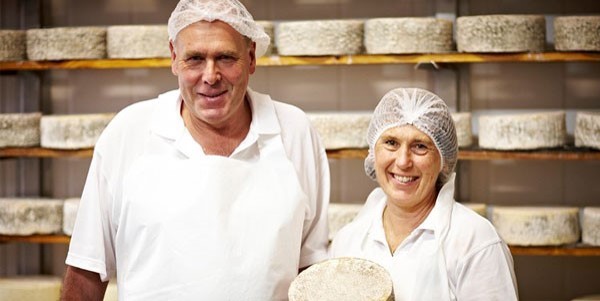A Taste of Authenticity: Floridia Cheese Melbourne and Its Craftsmanship
Wiki Article
Opening the Keys of Artisanal Cheese Making: A Detailed Do It Yourself Guide
In the realm of cooking workmanship, artisanal cheese making stands as a testament to the delicate equilibrium between custom and innovation. Each step in the procedure, from picking the best milk to improving aging strategies, holds within it a riches of expertise gave through generations. As we start this journey to debunk the art of developing exquisite cheeses, we are faced with a tapestry of tricks and skills waiting to be unwinded. Join us as we discover the intricacies of this ancient craft, where art, persistence, and scientific research merge to create flavors that entice the senses.Choosing the Right Milk
When getting started on the trip of artisanal cheese making, the choice of milk plays a vital function in figuring out the high quality and qualities of the final item. The kind of milk selected affects the flavor, appearance, and on the whole account of celebrity. Raw milk, directly from the animal, is favored by several artisanal cheesemakers as a result of its special blend of enzymes, microorganisms, and taste compounds. Making use of raw milk comes with dangers and regulations, making pasteurized milk a more secure alternative for beginners.When choosing milk for cheese making, it is vital to take into consideration the fat material. Greater fat content in milk can cause a creamier and richer cheese, while lower fat material might lead to a drier and stronger structure. In addition, the source of the milk, whether from cows, goats, lamb, or buffalo, adds distinct flavors and features to celebrity (Floridia Cheese Melbourne). Each sort of milk brings its own nuances, permitting a wide variety of cheese selections to be crafted based on the picked milk. Ultimately, the choice of milk is an essential choice that sets the foundation for a successful artisanal cheese-making venture.
Culturing and Coagulating
To initiate the cheese-making process, the critical steps of culturing and coagulating should be thoroughly performed to transform milk right into curds and whey. The type of society utilized can dramatically affect the flavor, structure, and ripening of the final cheese product.

The timing and temperature level control throughout culturing and coagulation are crucial elements that influence the final end result of celebrity. Appropriate implementation of these actions is crucial to make sure the desired structure, flavor, and uniformity of the artisanal cheese being generated.
Draining and Pressing Curds
After the milk proteins have actually coagulated and the curds have actually been cut to launch whey, the next critical action in artisanal cheese making involves draining and pressing the curds to attain the wanted texture and uniformity of the final cheese item. Draining pipes is the procedure of dividing the curds from the whey. This can be done by moving the curds into a cheesecloth-lined bowl-shaped sieve or mold and permitting the whey to drain pipes off normally. The time for draining here are the findings pipes can differ relying on the kind of cheese being made and the desired moisture material.Pressing assists remove any type of remaining whey and compacts the curds to develop a strong cheese wheel. Correct draining and pushing are crucial steps that considerably impact the quality and attributes of the artisanal cheese being created.
Aging and Flavor Methods
Carrying out meticulous aging and flavoring methods is crucial in boosting the depth and intricacy of artisanal cheeses, boosting their taste accounts to beautiful degrees of improvement and refinement. Aging plays an essential role in establishing the one-of-a-kind flavors and structures that distinguish artisanal cheeses. Throughout the aging procedure, cheeses are stored in carefully managed environments where elements such as humidity, temperature level, and air movement are manipulated to motivate the development of helpful molds and bacteria. This regulated setting allows the cheese to grow gradually, creating abundant tastes and complicated scents.Seasoning methods also contribute substantially to the final taste of artisanal cheeses. Cheesemakers might choose to present extra flavors by integrating components such as herbs, spices, and even fruits into celebrity during the manufacturing procedure. Additionally, some cheeses are washed or scrubed with various fluids, such as brine or alcohol, to enhance their textures and tastes.
Covering and Storing Cheeses

Verdict
Finally, mastering the art of artisanal cheese making includes thoroughly selecting the ideal milk, complying with accurate culturing and coagulating processes, draining and pressing curds successfully, and utilizing numerous aging and flavor methods. By complying with these steps diligently and with attention to detail, you can produce your very own tasty and distinct cheeses at home. Remember to wrap and save your cheeses appropriately to make sure look at more info optimum taste and structure advancement. Delighted cheese making!Each kind of milk brings its very own nuances, enabling for a wide array of cheese varieties to be crafted based on the picked milk.After the milk proteins have coagulated and the curds have actually been reduced to launch whey, the following crucial step in artisanal cheese making involves draining and pushing the curds to achieve the desired structure and uniformity of the final cheese item. The majority of cheeses need to be wrapped in wax paper or cheese paper to allow them to take a breath while protecting them from drying out. For cheeses that require to continue aging, such as bloomy skins or cleaned skins, ensure they are kept in an awesome atmosphere like a cheese cavern or a refrigerator set to the ideal temperature. By paying interest to the covering and storage space of artisanal cheeses, cheese makers and enthusiasts can maintain the honesty of these specials and completely enjoy their intricate tastes.
Report this wiki page